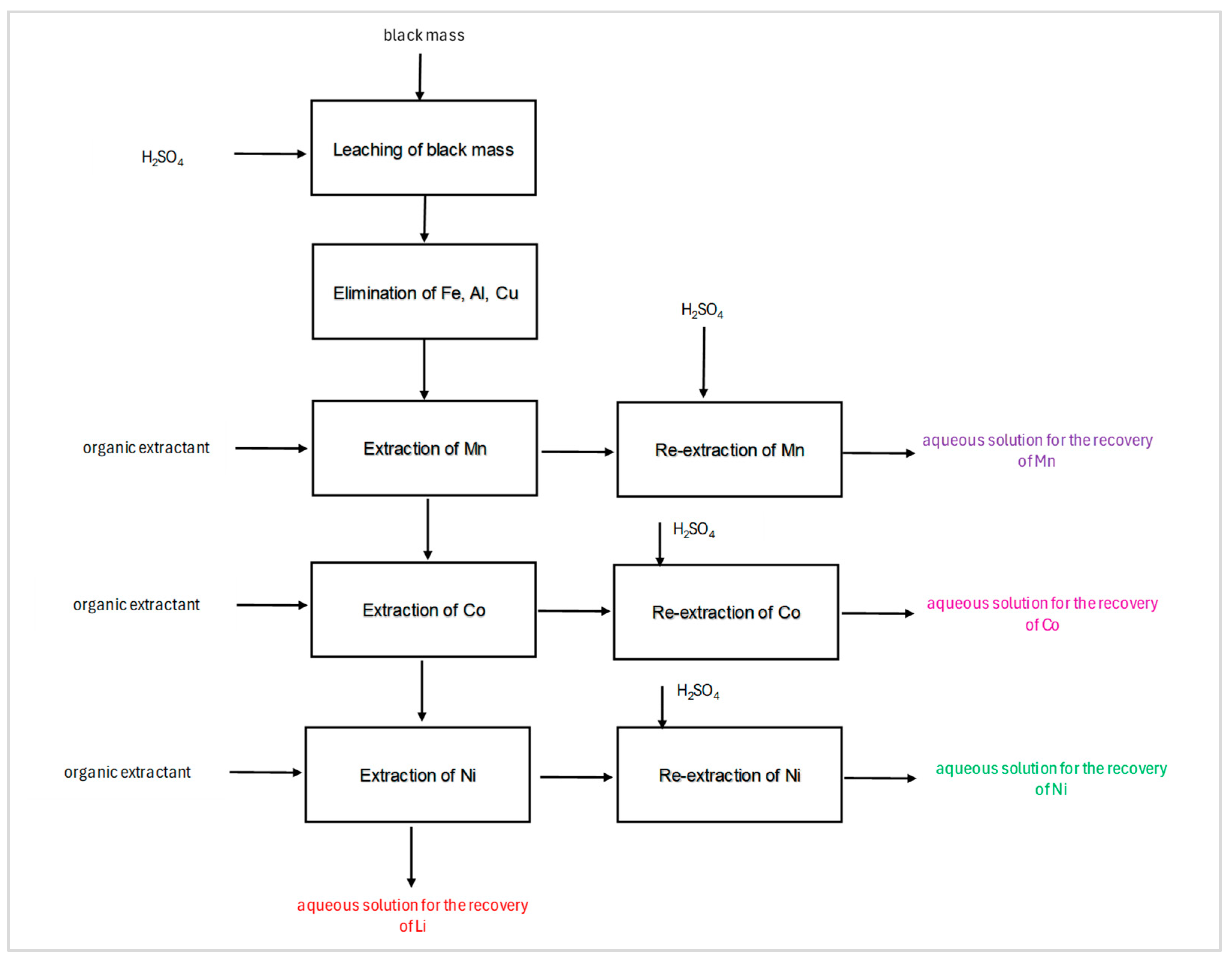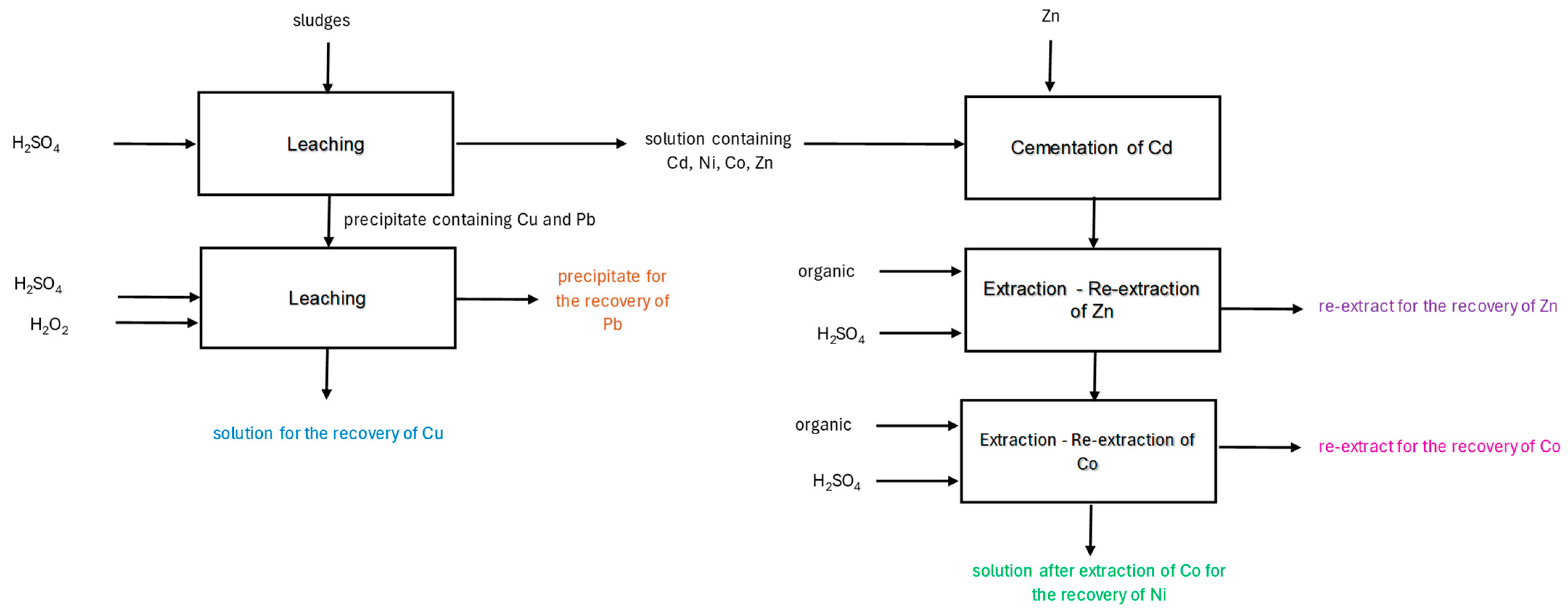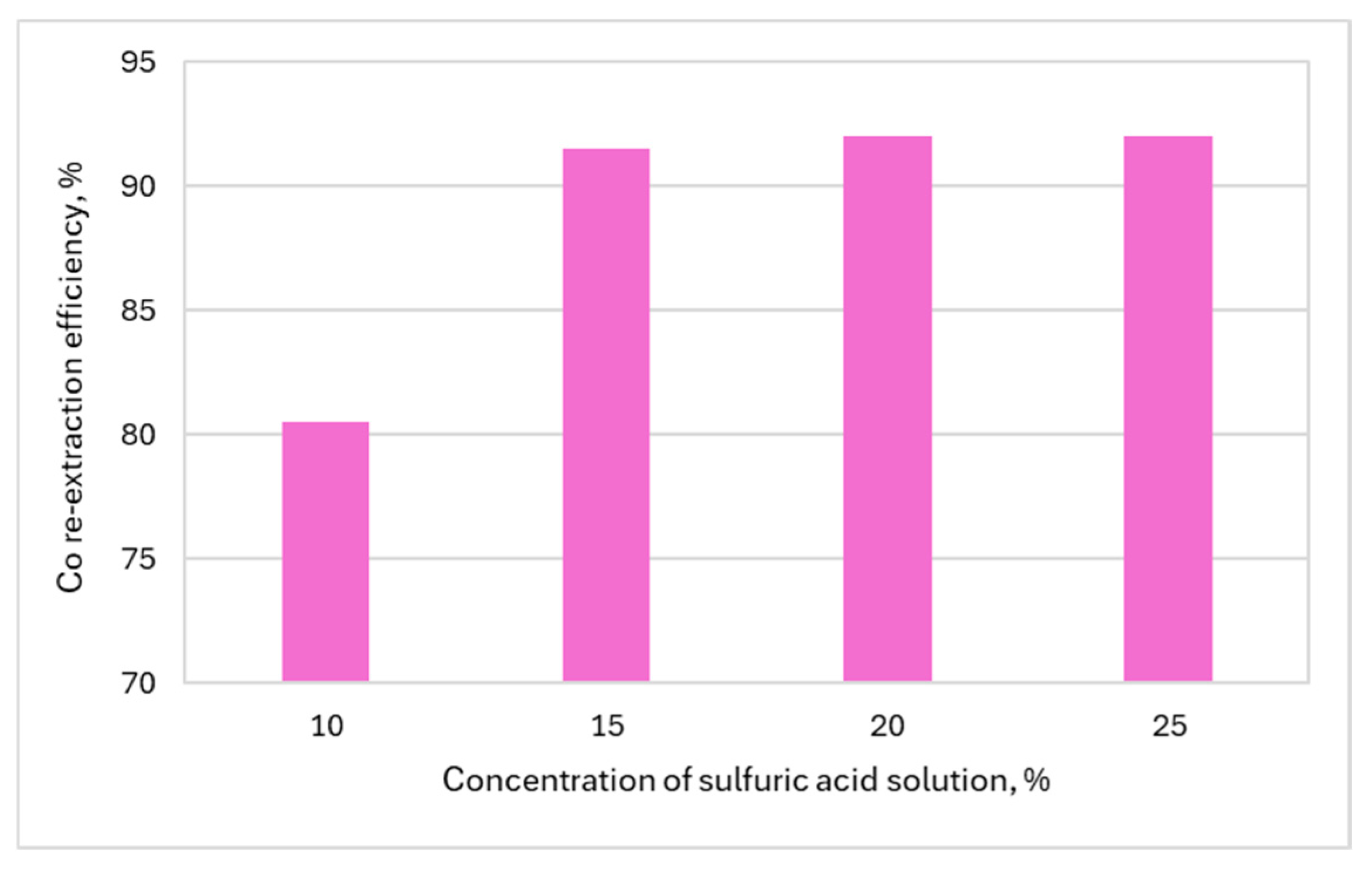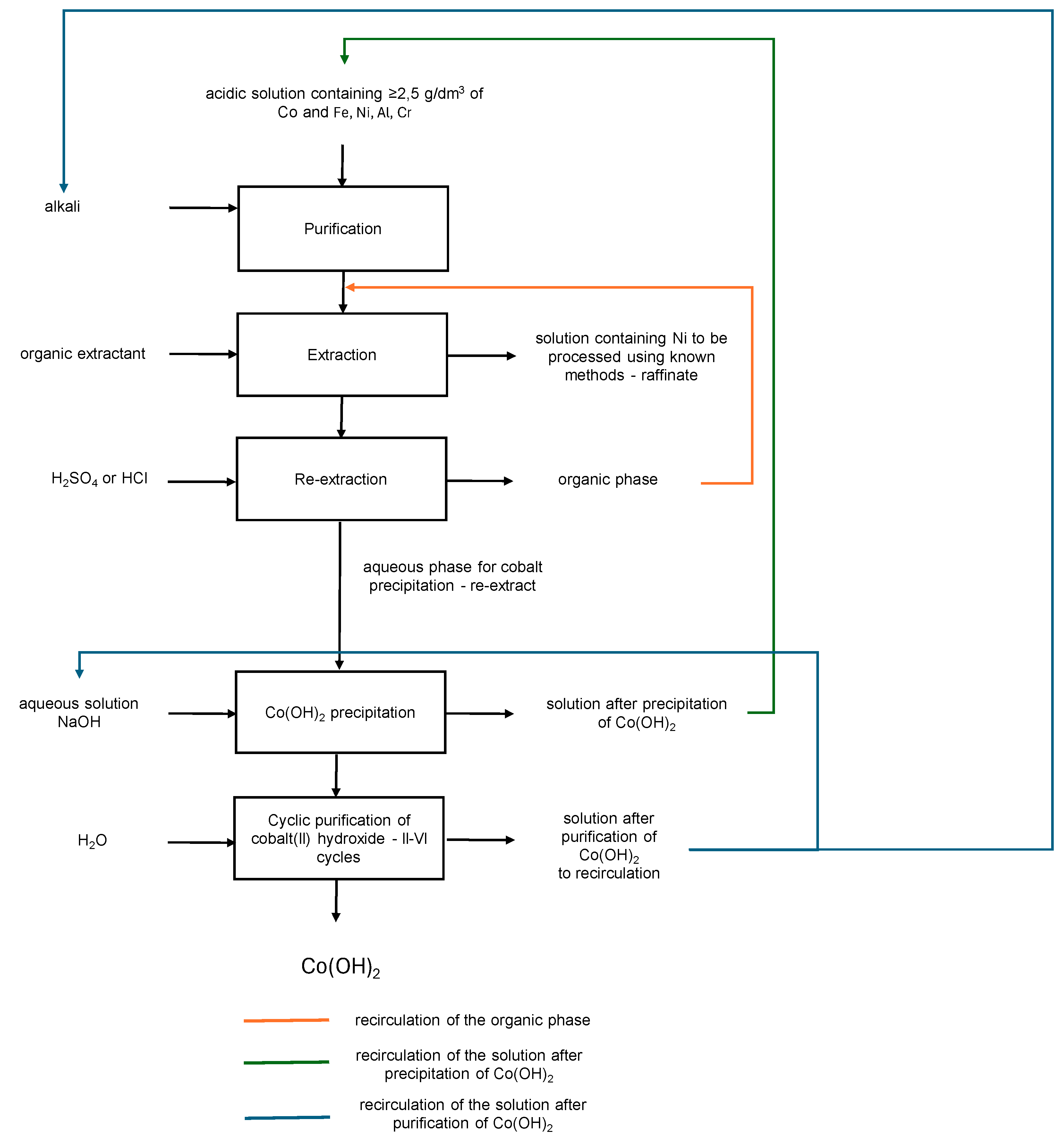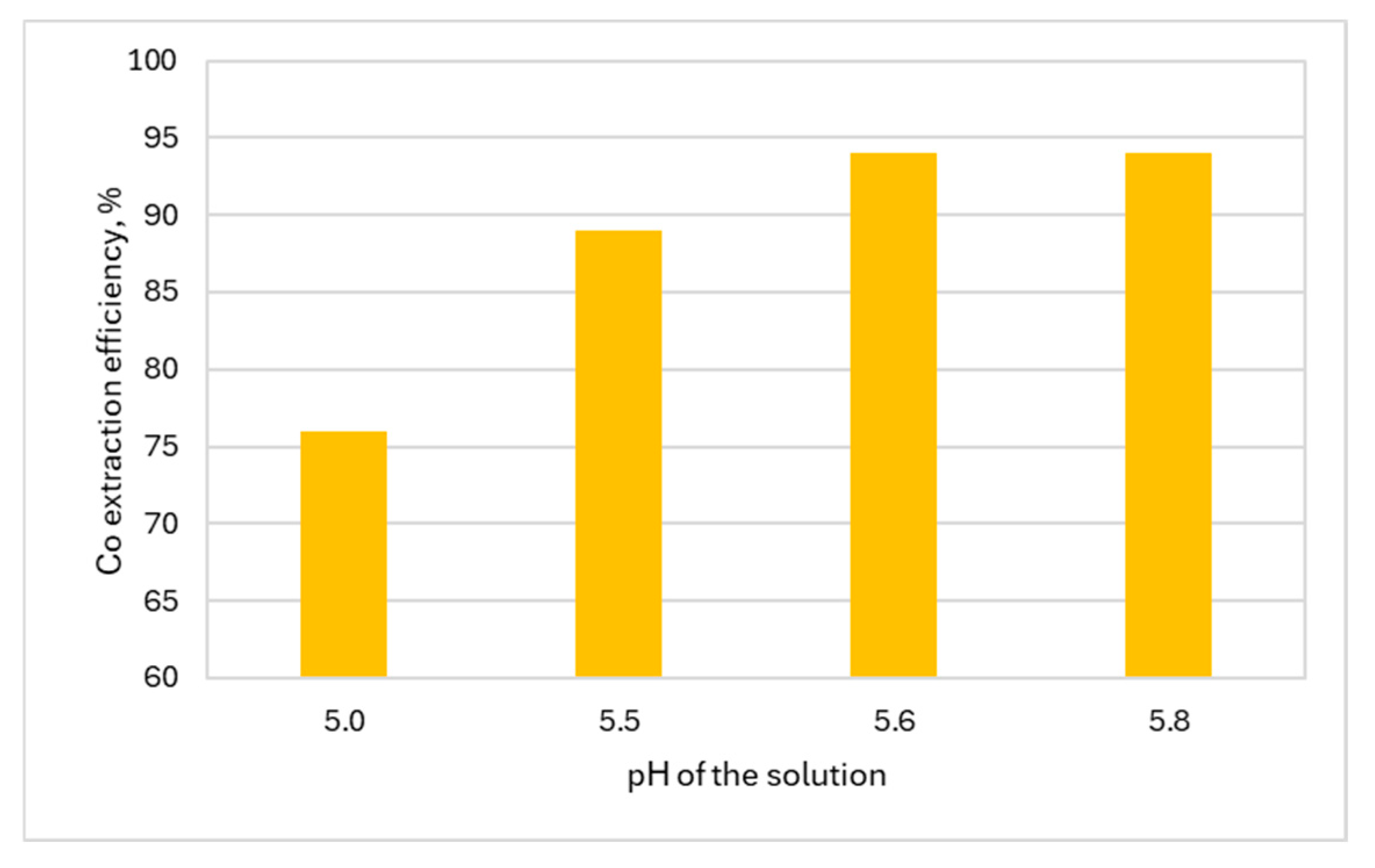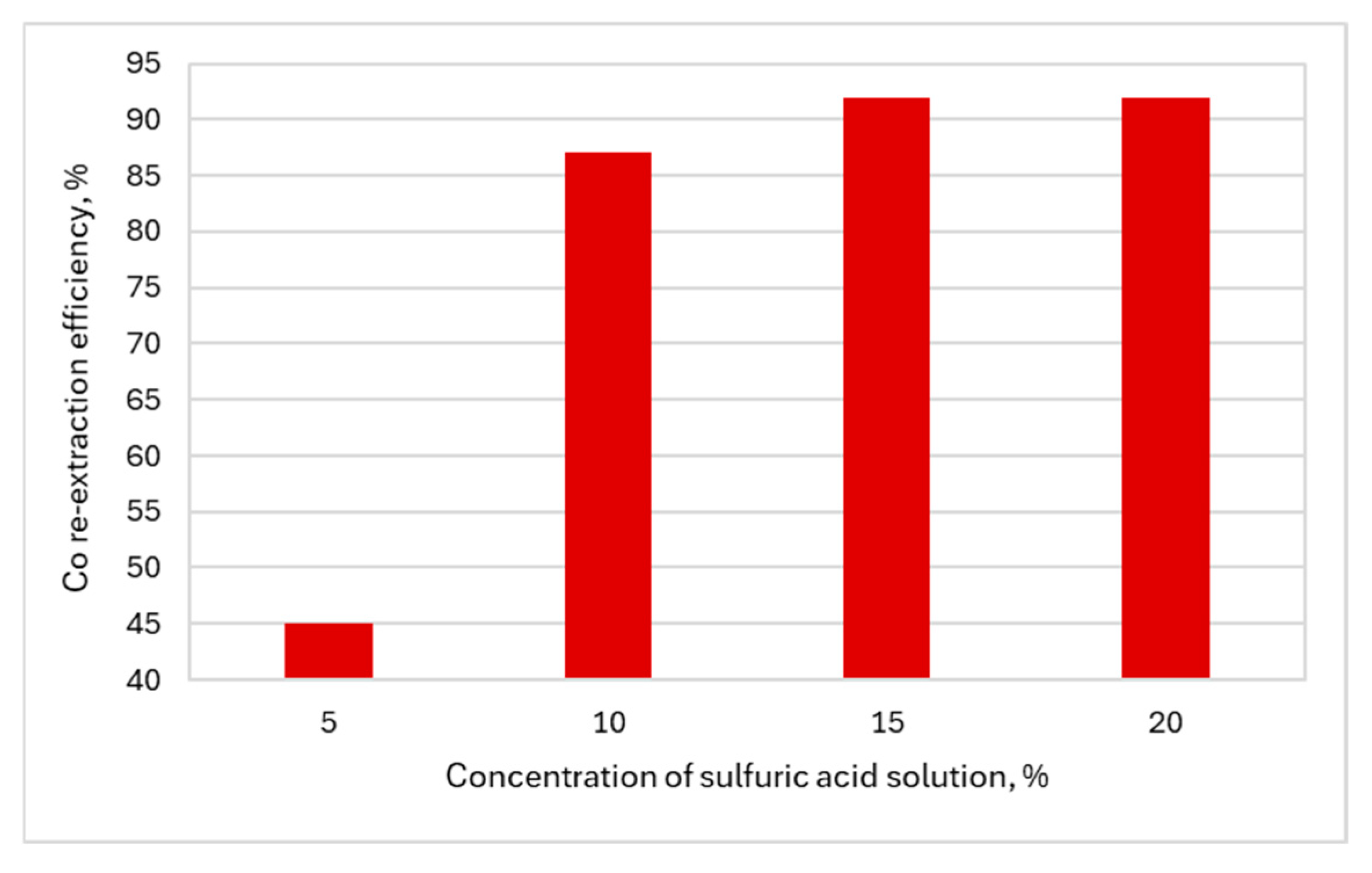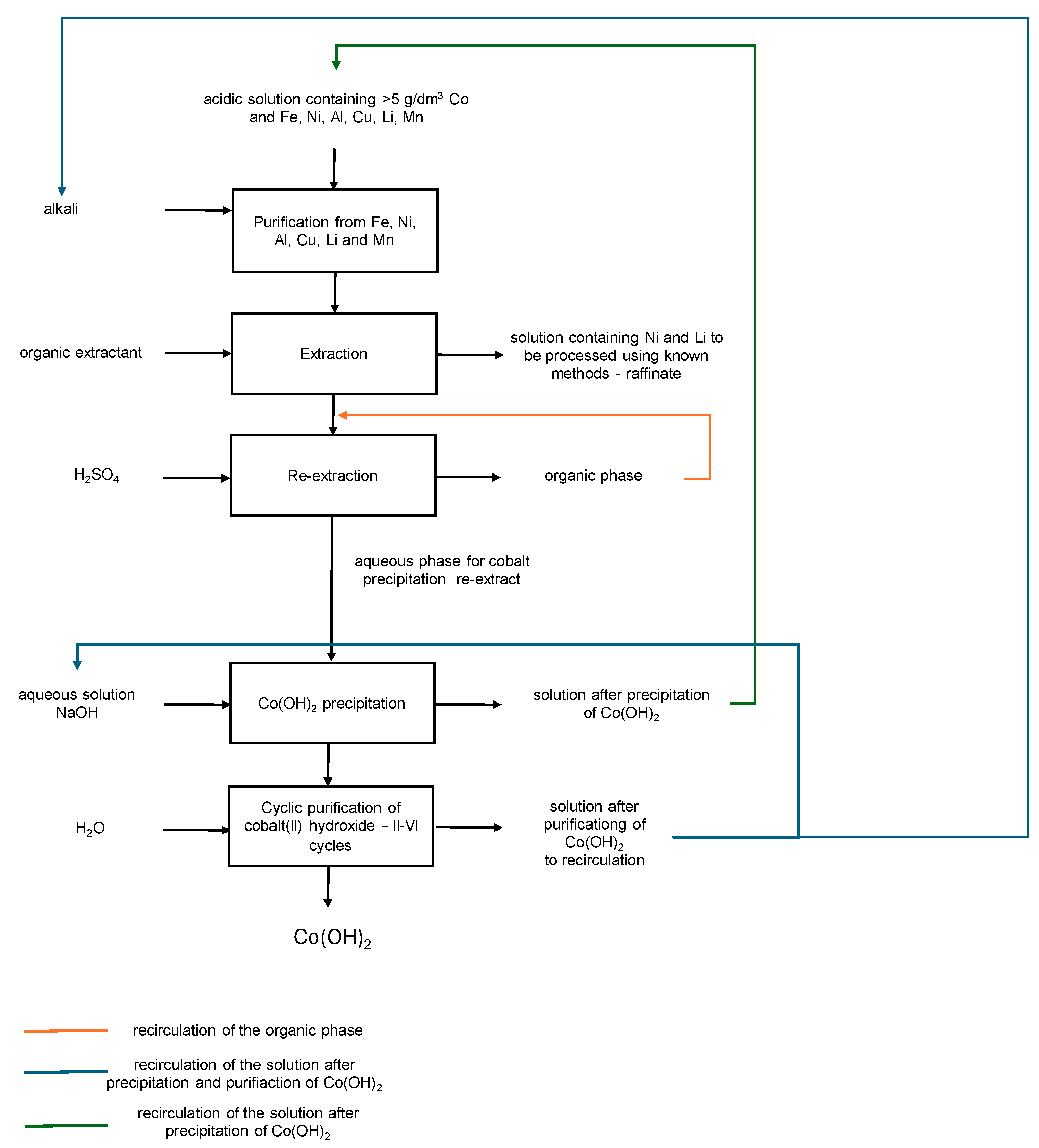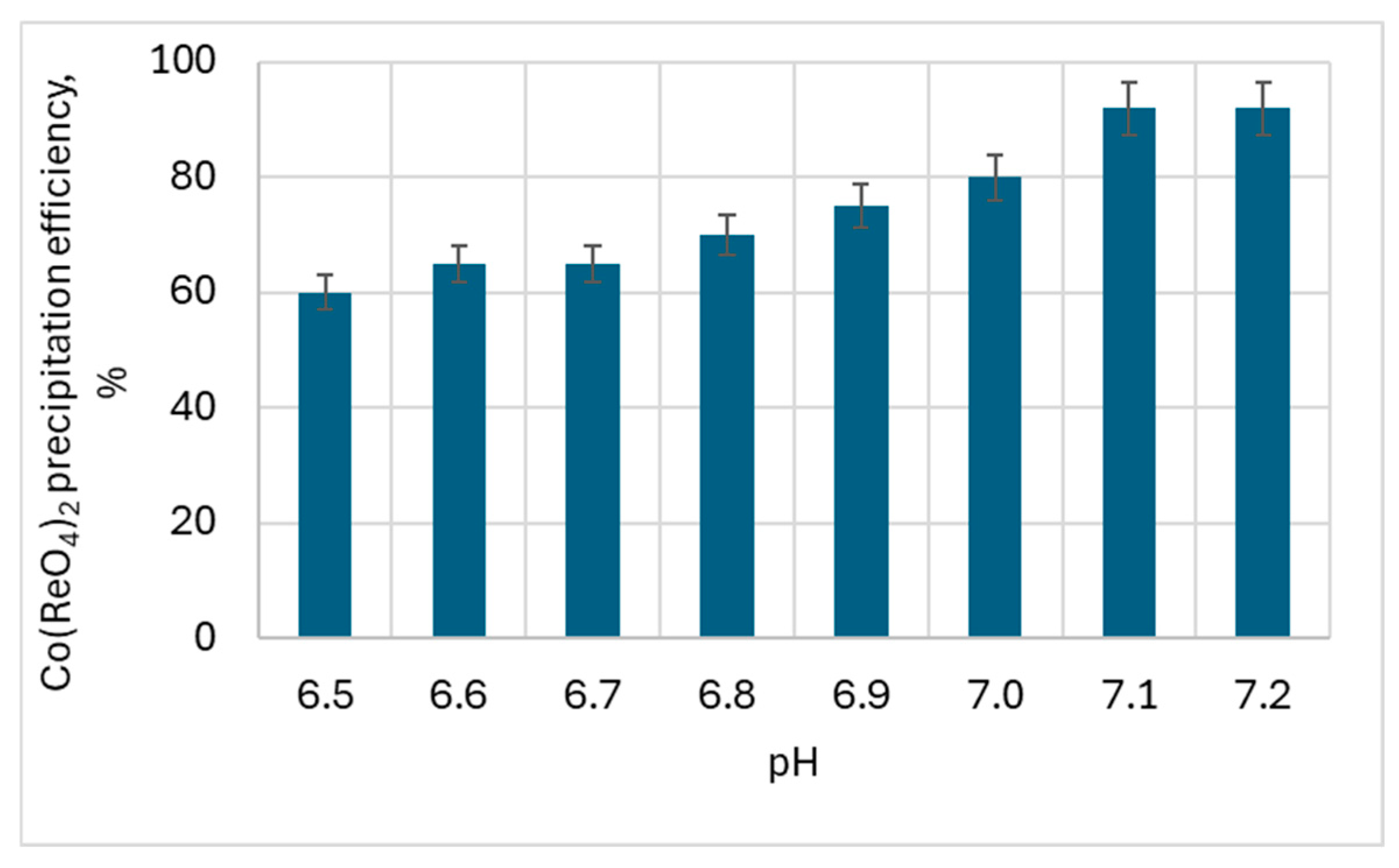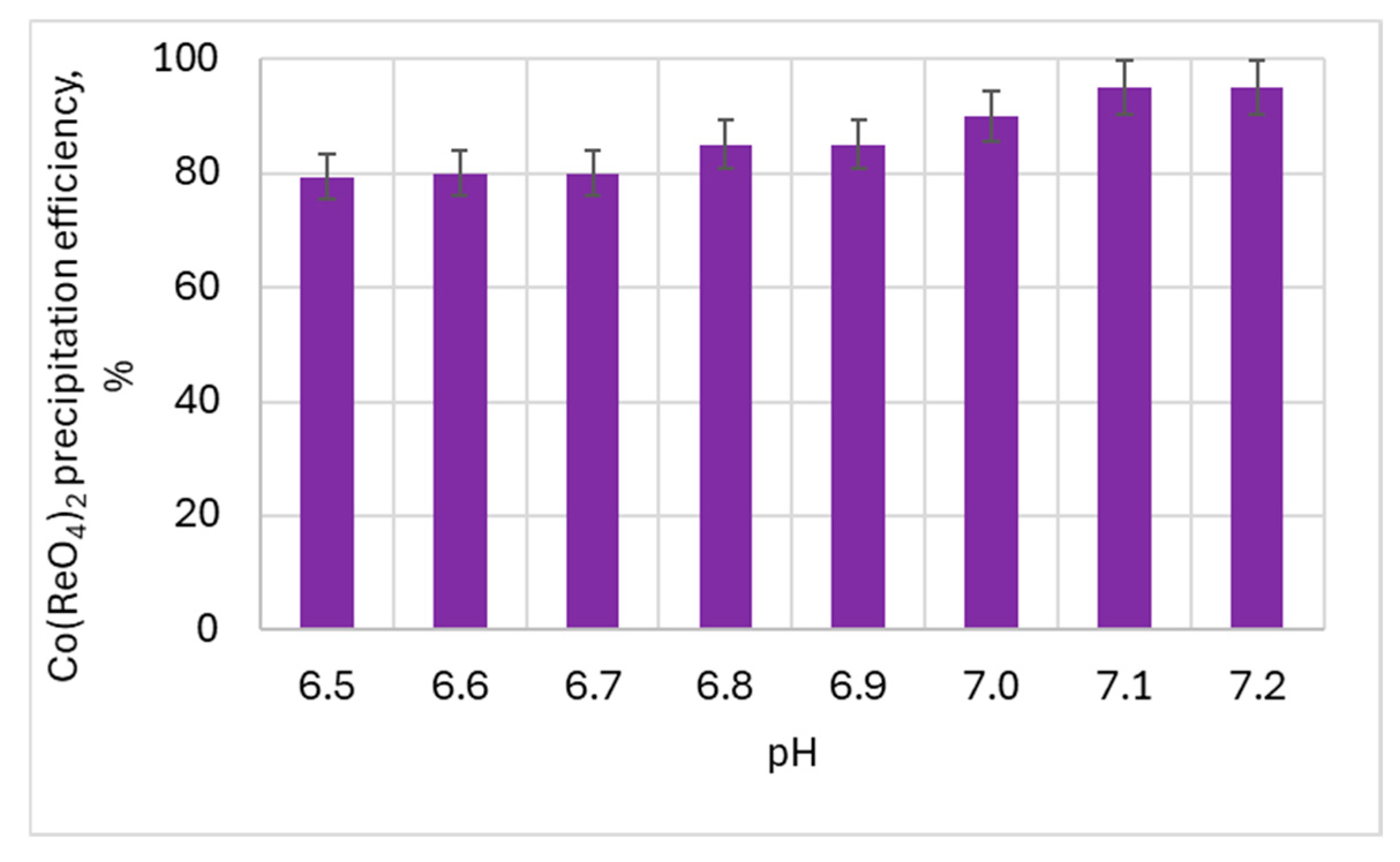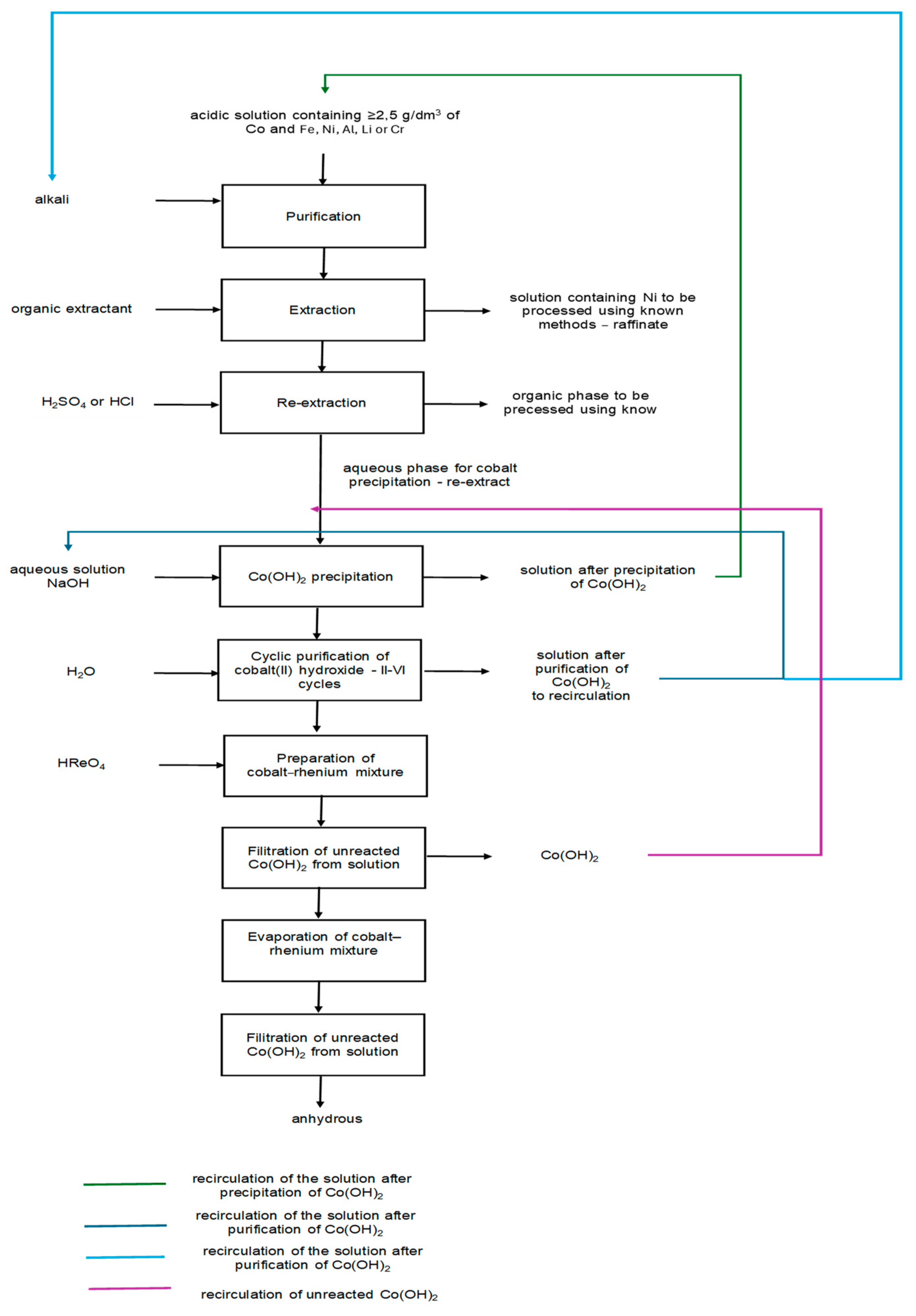1. Introduction
Rhenium is a metal that occurs extremely rarely in nature, yet it forms a number of compounds in various oxidation states. The most stable are rhenium compounds in higher oxidation states, i.e., VI and VII. The physicochemical properties of rhenium, including its high melting point (>3180 °C), substantial density (21.0 g/cm
3), elevated hardness (7 on the Mohs scale), exceptional strength, remarkable thermal and chemical resistance, as well as its amenability to plastic forming, determine its use in many areas [
1,
2,
3]. Thus, it is used in the following industries: aviation [
4,
5,
6], petrochemical [
7,
8,
9], defense, and catalysis [
1,
10,
11]. It should be emphasized here that 81% of the world production of rhenium is used in the production of alloys and superalloys [
12,
13,
14]. However, only 13% is used in catalysis, mainly in catalytic reforming [
15,
16,
17].
This publication describes methods of obtaining cobalt(II) perrhenate entirely from waste. This compound is used in the production of Co-Re alloy powders [
18,
19].
There are reports in the literature on the properties, methods of production and use of cobalt(II) perrhenate. Therefore, the first report in the literature regarding the preparation of cobalt(II) perrhenate came from the 1930s, when H. Briscoe, P. Robinson and A. Rudge obtained the above-mentioned compound in the reaction of CoCO
3 with HReO
4 [
20].
In 1949, W. Smith and G. Maxwell obtained Co(ReO
4)
2∙4H
2O in a reaction of HReO
4 with CoCO
3 or Co(OH)
2. Co(ReO
4)
2∙4H
2O was placed in a desiccator with calcium chloride to obtain Co(ReO
4)
2∙3H
2O. Complete dehydration occurred only after drying at 105 °C. This publication also determined the solubility of the produced salts [
21].
In 1978, L. Zajtseva and his team determined the composition and physicochemical properties of Co(ReO
4)
2 and Co(ReO
4)
2∙4H
2O. Cobalt(II) perrhenate tetrahydrate was produced via the reaction between perrhenic acid and basic cobalt(II) carbonate [
22].
An article appeared in Zhurnal Neorganicheskoj Khimii in 1990 in which the symmetry and parameters of the crystal lattice of anhydrous cobalt(II) perrhenate were determined. It was found there that this compound is isostructural to Mg(ReO
4)
2 and crystallizes in a hexagonal Zr(MoO
4)
2-type crystal system [
23].
In 1992, W. Baur, W. Joswig, G. Pieper and D. Kassner determined the crystallographic structure of cobalt(II) perrhenate. They found that Co(ReO
4)
2 has a rutile-type structure by ordering two cations [
24].
The effect of gaseous ammonia solution on crystalline cobalt(II) perrhenate pentahydrate was investigated by L. Maslov and his team in 1994 [
25].
In 1995 in Matt. Cryst. Liq. Cryst., an article was published in which insulating layers in ferromagnets were described, consisting of perrhenates of different metals, including Co(ReO
4)
2 [
26].
In the same year, A. Butz and his team obtained and determined the crystal structure of cobalt(II) perrhenate tetrahydrate. Co(ReO
4)
2∙4H
2O was obtained by reacting cobalt(II) carbonate with perrhenic acid, where carbonate was used with a 20% excess. The authors of this work showed that two stages of dehydration occur below 200 °C (first dehydration—120–130 °C, second dehydration—165–175 °C) and in each of these stages, two hydration waters are lost. The publication also specifies the decomposition temperature range of the above-mentioned products: 840–930 °C [
27].
In 1997, C. Toradi and his team examined the magnetic properties of anhydrous cobalt(II) perrhenate [
28].
The crystal structure of anhydrous cobalt(II) perrhenate was determined in 1998 by A. Butz, G. Miehe, H. Paulus, P. Strauss and H. Fuess. Co(ReO
4)
2 was obtained by dehydration of the hydrated form. Thermal analysis revealed that within a narrow temperature range, between the Co(ReO
4)
2∙4H
2O and Co(ReO
4)
2∙2H
2O structures, the trihydrate form occurs. The research suggested that Co(ReO
4)
2∙3H
2O molecule should be made from Co(ReO
4)
2∙6H
2O molecules [
29].
In 1998, C. Mujica examined and consequently determined the crystallographic structure of Co(ReO
4)
2∙4H
2O. The analysis results indicated that the cobalt ion is coordinated in an octahedral arrangement, with two perrhenate anions and four water molecules surrounding the central cobalt atom [
30].
In 1999, M. Varfolomeev determined the crystallographic structure of cobalt(II) perrhenate tetrahydrate. He showed that single crystals are triclinic and isostructural to Cu(ReO
4)
2∙4H
2O [
31].
In 2010, L. Liu and his team examined the antifriction properties of cobalt(II) perrhenate tetrahydrate in temperatures spanning from 25 to 750 °C. Co(ReO
4)
2∙4H
2O was obtained in a reaction of CoO with Re
2O
7 and water [
32].
In 2018, J. Wang and his team produced a composite in the form of Co(ReO
4)
2/MoS
2 as an additive that could improve oil lubricity and reduce friction. The tests were carried out at temperatures up to 600 °C. It has been shown that at temperatures above 450 °C, cobalt(II) perrhenate plays the main role as a friction reducing agent [
33].
2. Materials and Methods
Perrhenic acid was obtained by leaching the superalloy scrap, with a granulation of less than 1 mm. This process involved using a solution of sulfuric acid with oxidizing agents (hydrogen peroxide and/or nitric acid) as a leaching agent.
Table 1 presents the varied compositions of the superalloy scrap. Besides rhenium, these materials also contained significant amounts of nickel (43–53%), cobalt (7–22%), chromium (4–10%), aluminum (13–15%) and iron (up to 1.3%). After leaching, a solution containing 1.5 g/dm
3 of rhenium, nickel, cobalt, iron, chromium and aluminum was produced.
This solution was used in the recovery of rhenium in the form of NH
4ReO
4 (catalytic purity, Innovator, Gliwice, Poland), using ion exchange technology developed at the Łukasiewicz Research Network—Institute of Non-Ferrous Metals (Łukasiewicz-IMN). Then, using this technology, perrhenic acid was obtained, containing 15–900 g/dm
3 of Re and <0.0001% of each of the following impurities: Ca, K, Mg, Cu, Na, Mo, Pb, Fe, Ni, NH
4+, Bi, Zn, W, As and Al (Innovator; Gliwice; Polska) [
19,
34,
35].
Three types of waste were tested as a source of cobalt: two from recycling, i.e., nickel-based superalloy scrap (
Table 1,
Figure 1) and battery mass (black mass) made from Li-ion battery waste (
Table 2), as well as sludge from a national zinc producer using the electrolytic method (
Table 3) [
36].
Figure 2 shows a scheme for obtaining a multi-component solution, containing cobalt, resulting from the leaching of superalloy scrap.
Figure 3 shows a scheme for the further processing of the solution to obtain materials suitable for cobalt recovery and/or production of cobalt(II) perrhenate.
Figure 4 shows XRD analyzes of battery masses.
Figure 5 shows a scheme for obtaining a solution for cobalt recovery and/or production of cobalt(II) perrhenate from battery mass, and
Figure 6 shows a scheme for obtaining a solution for cobalt recovery and/or production of cobalt(II) perrhenate from sludge from the Zn-Pb industry.
In Poland, rhenium is recovered from nickel-based superalloys, Ni-Co-Cr-Al concentrate, and refractory metal concentrate recovery. The potential of combining the processing of these two materials (black masses and waste of superalloys) is an exciting solution that needs to be developed. However, the material streams are complicated to clean and process, and the investor involved must be wealthy. The need for investment in this crucial area is pressing, but there is no such possibility at the moment [
36].
4. Analytical Methods
The analytical procedures were carried out at two specialized Centres—Analytical Chemistry Centre and the Functional Materials Centre (Łukasiewicz Research network—Institute of Non-Ferrous Metals).
To determine the rhenium concentration in Co(ReO4)2 and HReO4, an X-ray fluorescence spectrometer (ZSX Primus, Rigaku, Tokyo, Japan) was used. For the detection of ammonium ions in the aqueous perrhenic acid solution, a two-step process was utilized. First, the sample underwent distillation, followed by titration using the Nessler method.
The following instrumental techniques were utilized to analyze the concentrations of Zn, Pb, Bi, As, Al, Mn, Cu, Ca, K, Mg, Mo, W, Cr, Na, Fe, Ni and Co:
Graphite furnace atomic absorption spectroscopy (Z-2000, HITACHI, Tokyo, Japan);
Inductively coupled plasma–optical emission spectroscopy (ULTIMA 2, HORIBA Jobin-Ivon, Kyoto, Japan and Optima 5300V, PerkinElmer, Waltham, MA, USA);
Inductively coupled plasma–mass spectroscopy (Nexion, PerkinElmer, Waltham, MA, USA);
Flame atomic absorption spectrometry (THERMO SOLAAR S4, Thermo Fisher Scientific, Waltham, MA, USA, supplied with a flame module and deuterium background correction).
The Rigaku MiniFlex 600 XRD diffractometer, supplied with an X-ray tube with a wavelength of 1.5406 Å and a stripe detector, silicon D/TeX and a high-resolution 2.5” Soller slit on the primary and scattered beam, was used to perform XRD analyses.
The microstructural and elemental analyses were conducted using a high-resolution scanning electron microscope (SEM, Zeiss Gemini 1525, Carl Zeiss NTS GmbH, Oberkochen, Germany). This instrument was equipped with a Quantax xFlash®6 Bruker Nano X-ray, enabling energy-dispersive X-ray spectroscopy (EDS) for compositional analysis.
5. Results and Discussion
5.1. Results of the Tests of Producing Co(OH)2 from the Solutions Obtained from the Processing of Superalloy Scrap
Using a solution obtained after the elimination of Fe, Al and Cr, tests were conducted on the extraction and re-extraction of Co. The research was conducted in a wide range.
Figure 7 shows the influence of the solution’s pH on the Co extraction efficiency. The influence of acid concentration on the efficiency of Co re-extraction is presented in
Figure 8.
The application of the process conditions allowed for the Co extraction efficiency to reach the range of 89–94%. A Co extraction efficiency of 94% was obtained for the solution with pH 5.6. In the case of Co re-extraction, the efficiencies were in the range of 81–92%. A Co extraction efficiency of 92% was obtained for the sulfuric acid concentration of >15%. The re-extract obtained after the re-extraction of Co was directed to the stage of cobalt(II) hydroxide precipitation using an aqueous NaOH solution. At pH > 8.0, cobalt(II) hydroxide was precipitated, filtered and sent to the purification stage, and the resulting solution with a cobalt concentration of <0.01 g/dm
3 was recirculated. Purification was carried out cyclically with water (2–6 cycles), using 0.03 dm
3 of water in one cycle for every 10 g of precipitate, in such a way that Co(OH)
2 precipitate was mixed with water for 30 min at a temperature of up to 40 °C.
Table 4 shows the effect of cyclic purification on the purity of the target product.
As can be seen in
Table 4, the use of three purification cycles allowed us to obtain a high-purity product, i.e., cobalt(II) hydroxide, containing up to 80 ppm of metallic impurities in the form of Ni, Cr, Al and Fe.
Figure 9 shows the developed scheme for obtaining Co(OH)
2. The efficiency of the entire process was approximately 83%.
5.2. Results of the Tests of Producing Co(OH)2 from the Solutions Obtained during the Processing of Battery Mass
Using the solution obtained after the removal of Fe, Cu, Mn and Al (20.5 g/dm
3 of Co, 0.6 g/dm
3 of Ni, 0.1/dm
3 of Li, 0.2 g/dm
3 of Fe, 0.2 g/dm
3 of Cu, 0.5 g/dm
3 of Mn), tests were conducted on the extraction and re-extraction of Co.
Figure 10 shows the influence of the solution’s pH on the Co extraction efficiency. The effect of the acid concentration on the Co re-extraction efficiency is shown in
Figure 11.
The application of the researched conditions allowed the Co extraction efficiency to reach the range of 76–94%. A Co extraction efficiency of 94% was obtained for the solution with pH 5.6. In the case of Co re-extraction, the efficiencies were in the range of 45–92%. A Co extraction efficiency of 92% was obtained for the sulfuric acid concentration of >15%. The re-extract obtained after the re-extraction of Co was directed to the stage of cobalt(II) hydroxide precipitation using an aqueous NaOH solution. At pH > 8.0, cobalt(II) hydroxide was precipitated, filtered and sent to the purification stage, and the resulting solution with a cobalt concentration of <0.01 g/dm
3 was recirculated. Purification was carried out cyclically with water (2–6 cycles), using 0.03 dm
3 of water in one cycle for every 10 g of precipitate, in such a way that Co(OH)
2 precipitate was mixed with water for 30 min at a temperature of up to 40 °C.
Table 5 shows the effect of cyclic purification on the purity of the target product.
As can be seen in
Table 5, the use of three purification cycles allowed us to obtain a high-purity product, i.e., cobalt(II) hydroxide, containing up to 140 ppm of metallic impurities in the form of Ni, Cr, Al and Fe.
Figure 12 shows the developed scheme for obtaining Co(OH)
2. The efficiency of the entire process was approximately 82%.
5.3. Results of the Tests of Producing Co(OH)2 from the Solutions Obtained from the Processing of Was from the Zn-Pb Industry
The re-extract resulting from the re-extraction of Co was sent to the cobalt(II) hydroxide precipitation stage using an aqueous NaOH solution. At pH > 8.0, cobalt(II) hydroxide was precipitated, filtered and sent to the purification stage, resulting in a solution with a concentration of <0.01 g/dm3 of Co. The same purification procedure was used for processing Co(OH)2 obtained from superalloy scrap. The use of three purification cycles allowed us to obtain a high-purity product, i.e., cobalt(II) hydroxide, containing no more than 40 ppm of metallic impurities in the form of Ni (<5 ppm), Zn (<10 ppm), Cd (<10 ppm), Cu (<10 ppm) and Pb (<1 ppm). The efficiency of the entire process was approximately 86%.
5.4. Results of the Tests of Producing Co(ReO4)2
Despite obtaining high-purity solutions in all cases (metal contamination at the level <0.001 g/dm
3) containing significant amounts of Co (>2.5 g/dm
3), it was not possible to obtain an appropriately qualified rhenium(VII) salt from them, i.e., cobalt(II) perrhenate. This was not possible due to the significant content of sulfates >2% in the precipitated compounds. For this reason, Co(OH)
2—obtained from all three types of wastes—was selected for further research. The data showcasing the impact of rhenium concentration in perrhenic acid on the precipitation efficiency of Co(ReO
4)
2 are displayed in
Table 6 and
Figure 13.
The rhenium concentration in perrhenic acid demonstrated a notable effect within the examined range. A positive correlation was observed between the increasing concentration and the precipitation efficiency of cobalt(II) perrhenate. Across the selected concentration range, the precipitation efficiencies of the target compound varied from 60% to 92%. This indicates that cobalt(II) perrhenate can be successfully precipitated from perrhenic acid solutions with a broad range of rhenium concentrations. However, when considering the development of technologies aligned with sustainable development principles, it is crucial to minimize the production of waste solutions. This objective can be effectively achieved by utilizing more concentrated perrhenic acid solutions. Such an approach not only enhances the precipitation efficiency but also aligns with environmentally conscious practices by reducing the volume of waste generated during the process.
The next phase of the research focused on examining how pH affects the precipitation efficiency of cobalt(II) perrhenate. Experiments were conducted under the following conditions: pH range: 7.7 to 9.4, 1 h, temperature 75 °C, Re concentrations in perrhenic acid: 100 g/dm
3 and 350 g/dm
3. The results illustrating the relationship between pH and cobalt(II) perrhenate precipitation efficiency are presented in
Figure 14 and
Figure 15.
An important influence of pH on the cobalt(II) perrhenate precipitation efficiency was found. The best results for both acid concentrations were obtained at pH >7.1.
So it can be said with certainty that in order to precipitate cobalt(II) perrhenate with an efficiency of over 92%, the process must be carried out at pH 7.1. It was possible to obtain Co(ReO4)2 even at a pH over 6.5, but then the efficiency was in the range of 60–79%.
For the selected cobalt(II) perrhenate, its composition was analyzed. It had the following composition: 66.6% of Re and 10.5% of Co, and <10 ppm of Na, <10 ppm of Zn, <10 ppm of Al, <10 ppm of Ca, <10 ppm of K, <10 ppm of Fe, <5 ppm of Ni, <5 ppm of Cu, <5 ppm of Co, <5 ppm of Mg. The impurities allow for the use of the compound in the defense and aviation industries.
Additionally, XRD analysis was performed for cobalt(II) perrhenate precipitated at pH 7.1—
Figure 16.
6. Conclusions
This study demonstrated the feasibility of synthesizing anhydrous cobalt(II) perrhenate with a high purity, containing no more than 100 ppm of total metallic impurities. The process utilizes cobalt(II) hydroxide, derived from three distinct waste sources, in combination with perrhenic acid. To achieve optimal results, the reaction should be conducted under the following specific conditions: time 1 h, room temperature pH = 7.1, rhenium concentration in HReO4 350 g/dm3.
Drawing from the research findings presented, a novel hydrometallurgical process has been created for the production of cobalt(II) perrhenate. This innovative technology is notable for its complete reliance on solutions derived from waste leaching processes. The method is comprehensive and consists of a sequence of ten distinct stages, which are purification, extraction, re-extraction, precipitation of cobalt(II) hydroxide, cyclic purification, preparation of cobalt–rhenium mixture, filtration of the unreacted Co(OH)2, evaporation and drying. Furthermore, the process requires filtration steps between certain operations.
In
Figure 17, a scheme of the developed technology is presented in its entirety, with all the recirculation.




